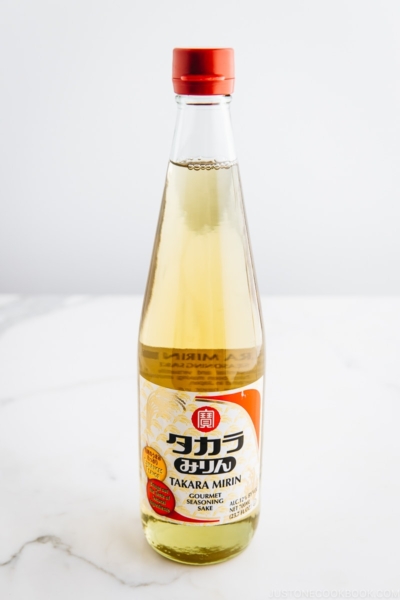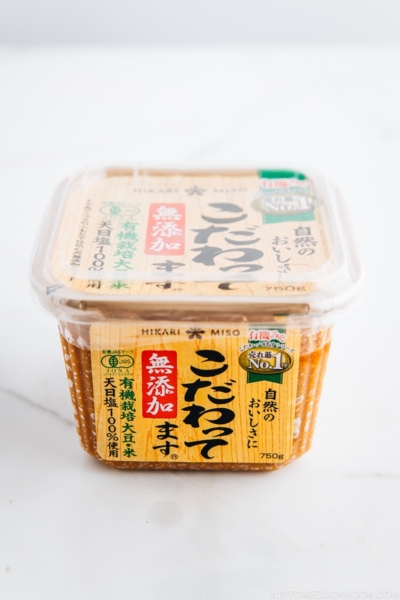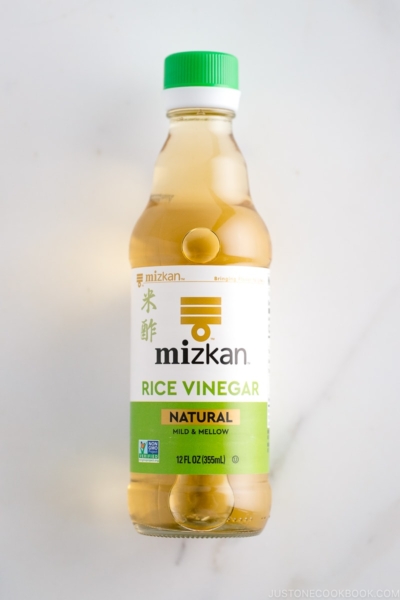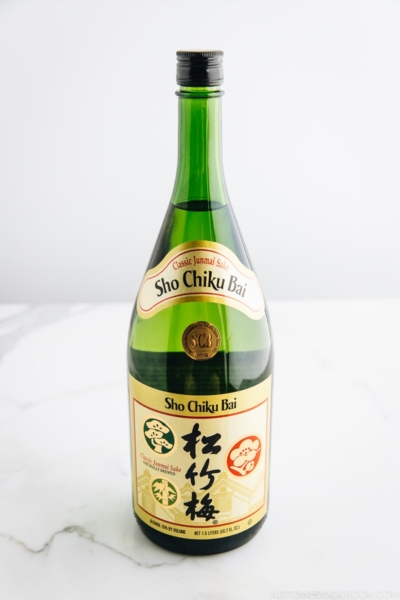Soy sauce is an all-purpose Japanese condiment full of umami and flavor. It’s an indispensable part of Japanese cuisine, consisting of soybeans, wheat, roasted grains, and sea salt. Today, let’s learn all about Japanese soy sauce, how it differs from other soy sauces, my recommended brands, and more!
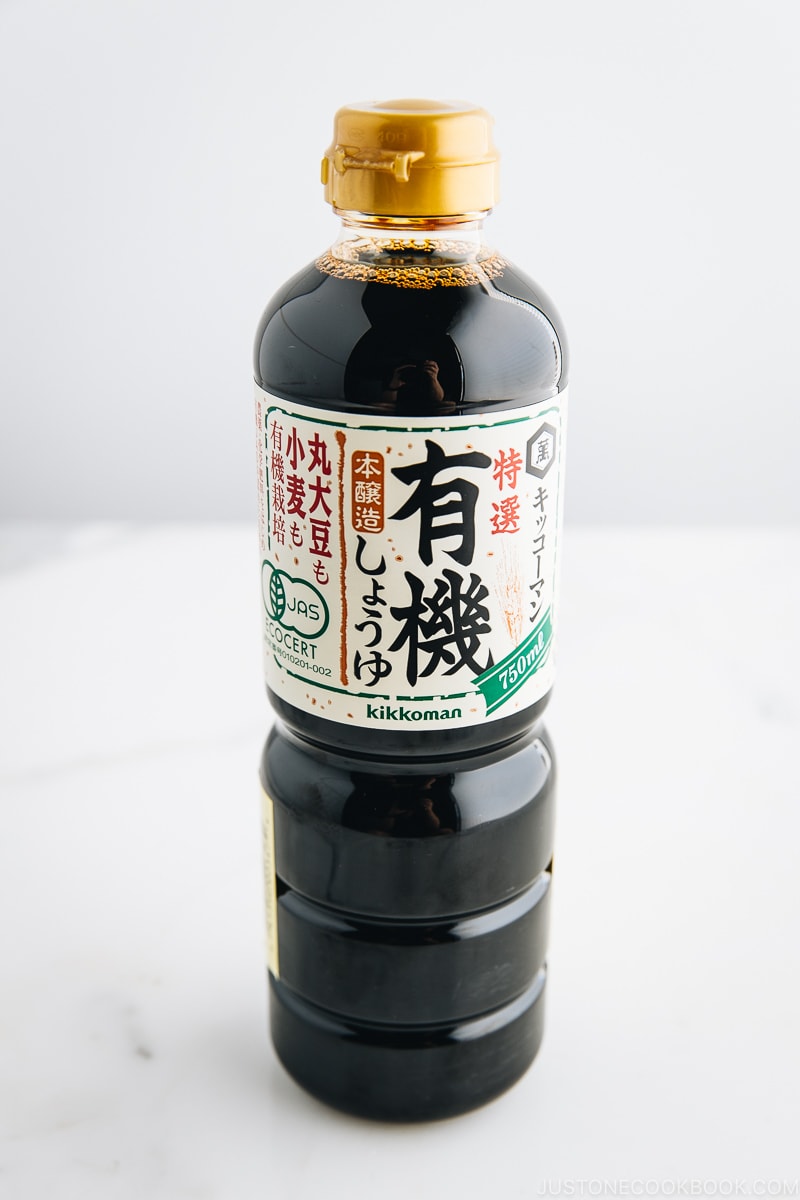
If you are familiar with Japanese or Asian cuisines, you likely recognize the dark brown, salty liquid in many dishes. Soy sauce is an all-purpose ingredient in Japanese cooking and many other East Asian and Southeast Asian cuisines.
When it comes to Japanese cooking, it’s crucial to use authentic Japanese soy sauce. But why? Below, we’ll delve into everything you need to know about this traditional condiment.
Table of Contents
What is Japanese Soy Sauce
Soy sauce is one of the foundational elements of East and Southeast Asian cooking. Originating in China over 2,000 years ago, it stands as one of the oldest condiments on the planet. From jiangyou in Chinese cuisine, shoyu in Japanese cuisine, and ganjang in Korean cuisine, to kecap manis in Indonesian cuisine, each variety of soy sauce offers unique flavors and levels of intensity.
Japanese soy sauce is called shoyu (醤油) and typically has a lighter, milder, and sweeter profile. It imparts flavor and color to dishes without overpowering them and is a vital component of stir-fries, pan-fried dishes, nimono (simmered dishes), noodle soups, glazes, and more.
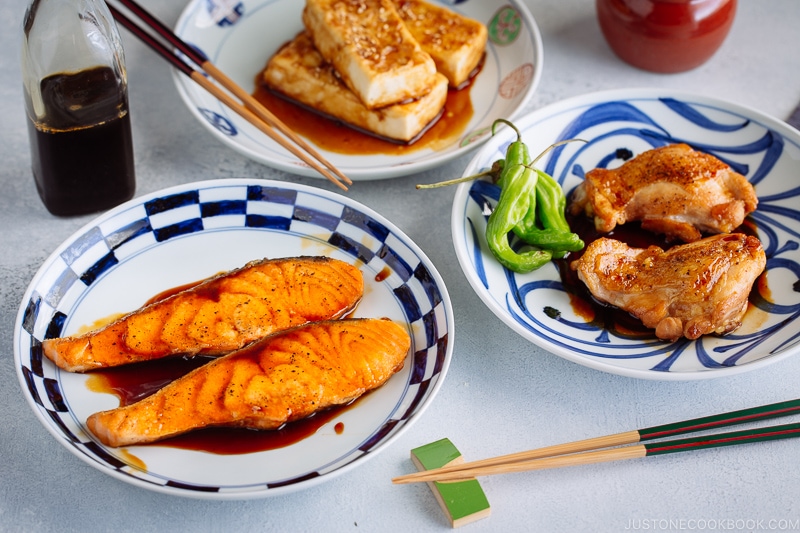
What Does It Taste Like
The primary taste of Japanese soy sauce is salty, but it also has a naturally sweet, slightly earthy, sour, and savory profile. Unlike salt, soy sauce undergoes fermentation, resulting in a highly complex and nuanced flavor.
You’ll notice the aroma of good soy sauce when heated. When adding it to a pan, try pouring it from the sides so that it cooks a little before seasoning the pan contents.
How is Japanese Soy Sauce Different from Others?
To cook Japanese food with integrity and achieve the best flavors and consistency, it’s important to use Japanese soy sauce.
Japanese soy sauce is made with equal parts of soybeans and wheat, whereas Chinese and Korean soy sauces have a higher ratio of soybeans to wheat. In general, Japanese soy sauce has a thin and clear consistency, making it an excellent choice for all-purpose cooking and table seasoning.
Soy sauces from other countries are tailored to their respective cuisines, and their taste and uses can differ significantly, which may alter your cooking. I’ve had readers who used Chinese dark soy sauce for Japanese dishes and wondered what went wrong. So, take note that Japanese soy sauce is different from Chinese soy sauces. Similarly, I use only Korean soy sauce for Korean dishes.
How It’s Made
Japanese soy sauce consists of soybeans, wheat, salt, and sometimes roasted grains. There are two types: traditionally and chemically produced.
- Traditionally production
The traditional brewing process involves soaking and steaming soybeans for several hours. Then, they are mixed with roasted and ground wheat flour and cultured mold (Aspergillus oryzae, the same yeast used to make miso paste) to make shoyu koji. This mixture ferments for three days.
The shoyu koji mixture is then combined with a salt brine called moromi and allowed to brew and ferment for several months. Finally, it is filtered, pasteurized, and bottled.
👉🏼 High-quality soy sauce uses natural fermentation and is labeled “naturally brewed.“
My family had the opportunity to visit the Kikkoman Factory in Noda, Japan, and learned a great deal about its production. You can read about our tour here.
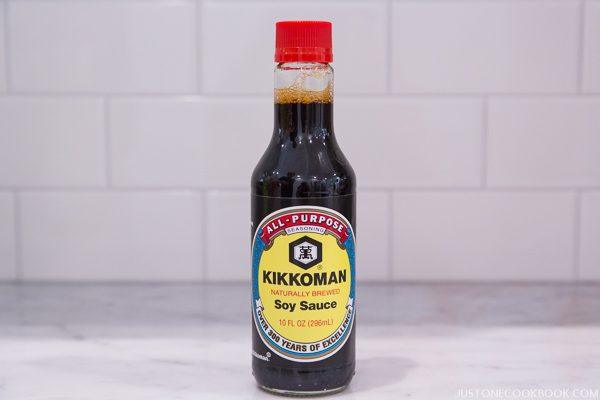
2. Chemical production
Chemical production is a cheaper and faster method of making it, where a chemical acid is added to break down the proteins in the soybeans and wheat. This method produces soy sauce in a few days instead of months. The finished product is usually flat and less aromatic in taste and flavor. Therefore, you’ll find additives and salt in the final product to boost color and flavor. If you see “hydrolyzed soy protein” or “hydrolyzed vegetable protein” on the label, it’s chemically produced.
Uses
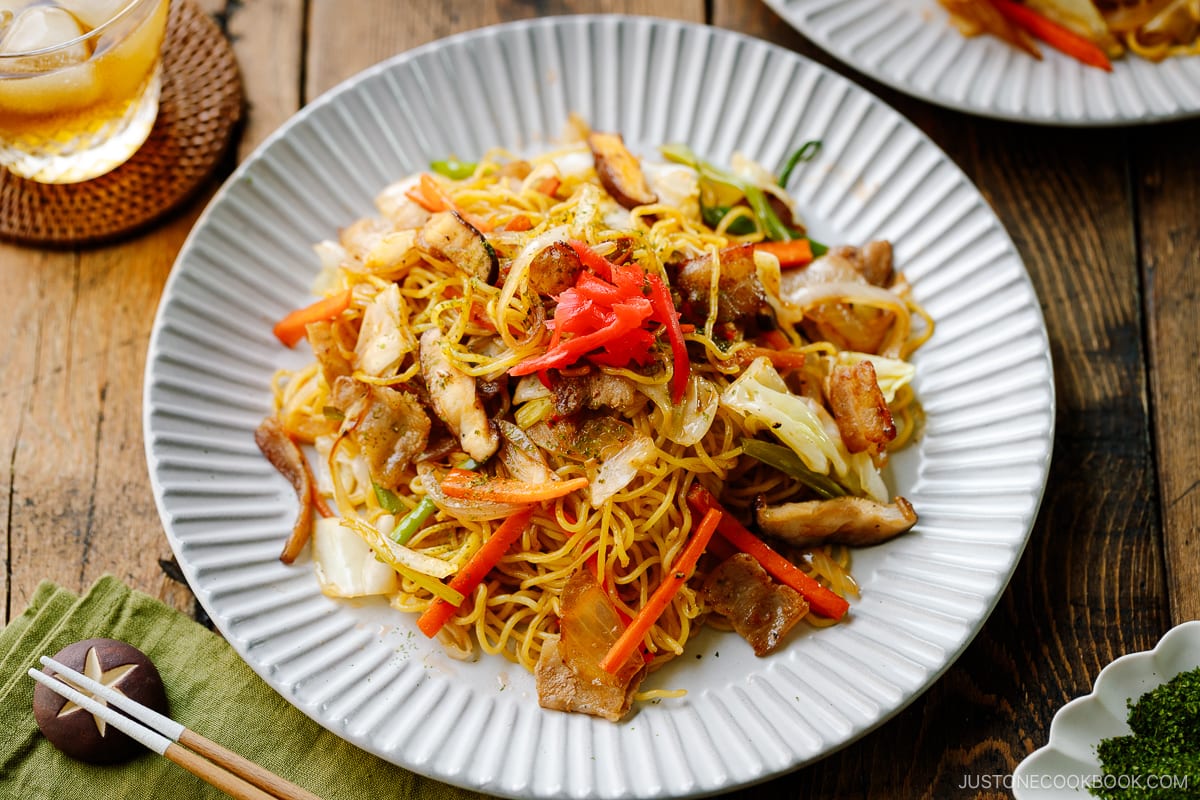
The Japanese use soy sauce in the following contexts:
- to flavor and enhance a dish
- to season ingredients
- to enhance the color of a dish
- to make sauces and dressing when combined with other ingredients
Its role is similar to salt, as you can add it while cooking or consuming with food. It lends fragrance and savory characteristics to dishes, including desserts! Without it, Japanese food wouldn’t be what it is today.
These days, Japanese soy sauce has gained widespread recognition, becoming almost as ubiquitous as ketchup. It’s now incorporated into numerous non-Asian cuisines to infuse dishes with depth of flavor.
🍦 Have you tried soy sauce ice cream? It’s AMAZING! Check out my Soy Sauce Caramel Ice Cream recipe!
Different Types of Japanese Soy Sauce
There are five main varieties of soy sauce. You will likely find the main soy sauce types outside of Japan, including gluten-free options.
- Koikuchi shoyu (濃口醤油)
- Usukuchi shoyu (淡口醤油)
- Tamari shoyu (たまり醤油)
- Saishikomi shoyu (再仕込み醤油)
- Shiro shoyu (白醤油)
1. Koikuchi Shoyu (Japanese Soy Sauce) 濃口醤油
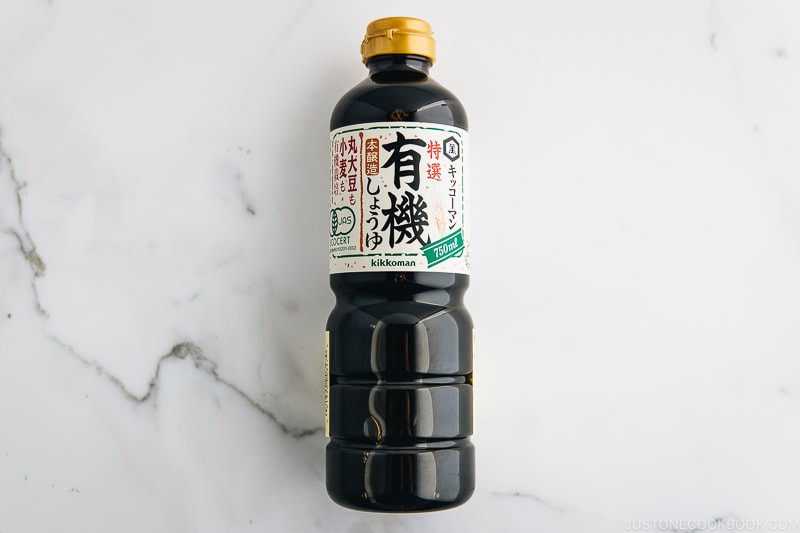
Typically made from wheat and soybeans, koikuchi shoyu, known as “regular” or “standard” soy sauce, is the most commonly used soy sauce in Japan. It has a well-rounded flavor, making it an all-purpose choice for cooking and seasoning a wide variety of dishes.
Koikuchi boasts a balance of umami, saltiness, sweetness, sourness, and bitterness, with a salt content of about 16%. It’s perfect for teriyaki chicken, teriyaki sauce, yakisoba, mapo tofu, and all your favorite Japanese dishes!
Koikuchi soy sauces are widely available outside of Japan, with Kikkoman being the dominant brand in the market. Though not always labeled as such, these standard choices are indeed koikuchi.
If you can, find marudaizu (丸大豆, “whole soybeans”), made with whole soybeans rather than soybean mash. This variety offers a rounder and more nuanced flavor. Reserve it for raw applications rather than cooking, where you’ll notice the difference.
My favorite brand is the organic version from Kikkoman, imported from Japan (pictured above). You can find it at Japanese supermarkets, H-Mart, Asian grocery stores, online grocery or on Amazon.
2. Usukuchi Shoyu 淡口醤油
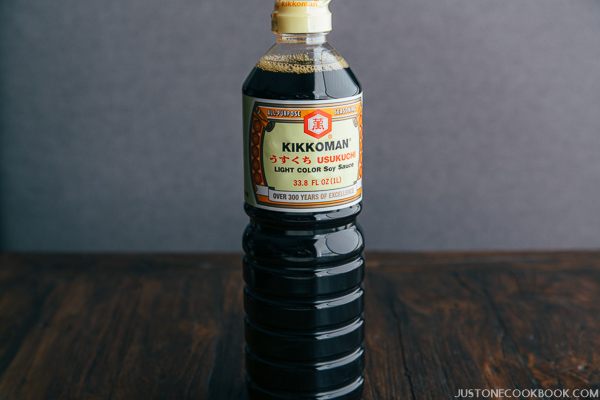
Usukuchi, translates to ‘light-colored soy sauce’, has a higher sodium content (18-19%) than regular soy sauce and is less umami. This is because the additional salt suppresses the fermentation process. Primarily used in southern Kansai region, it is employed in cooking dishes such as Takikomi Gohan (Japanese mixed rice) and braises. Unlike regular soy sauce, its light color prevents the final dish from darkening.
*Again, please don’t mistake usukuchi as the Chinese light soy sauce.
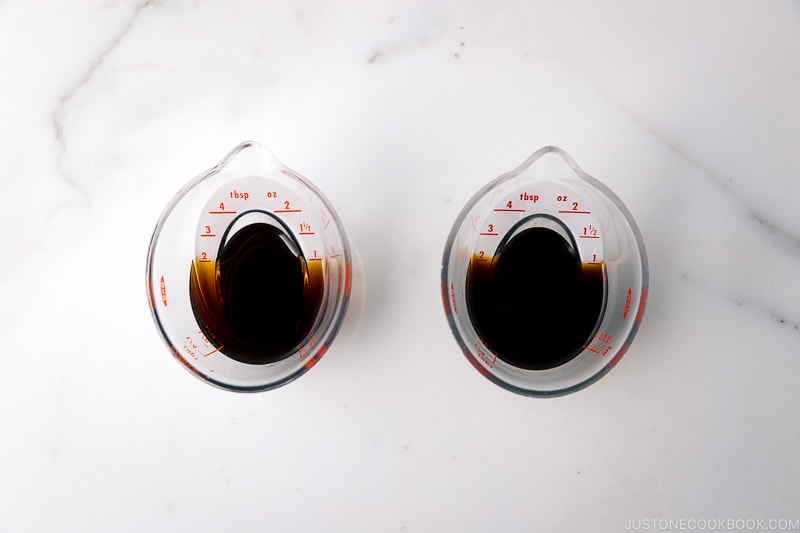
👉🏼 I use usukuchi soy sauce for udon noodle soup, chawanmushi, and simmered dishes (nimono).
3. Tamari Shoyu たまり醤油
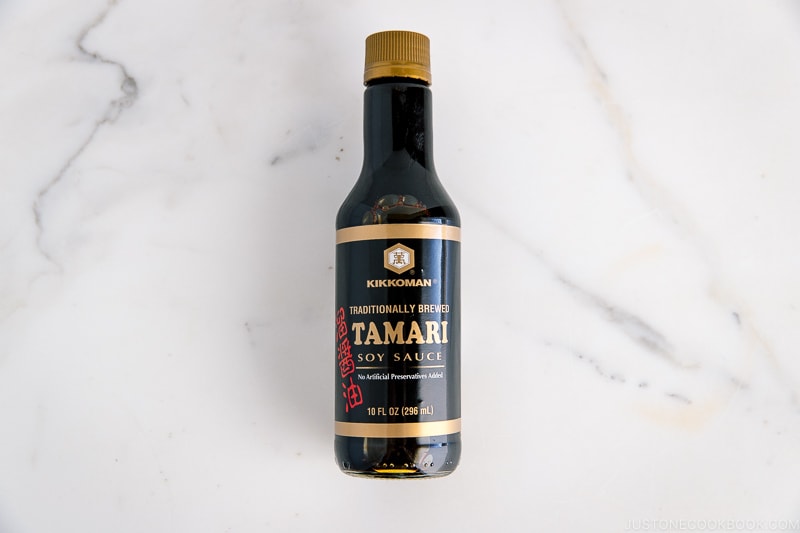
Tamari is a by-product of miso, consisting of the leftover liquid from pressing miso. It is popular in the Chubu (Nagoya) region, particularly in Aichi prefecture. Characterized by its thick, syrupy texture, rich umami taste, and fragrance, tamari is dynamic. It’s wonderful on sushi, sashimi, glazed dishes like teriyaki, or as a finishing seasoning. The salt content is around 16%.
The ingredients are just soybeans and contain little to no wheat. Some are gluten-free, but do check the label first. The texture and flavor differ from regular soy sauce, so it’s not the best gluten-free replacement.
👉🏼 Read more about Tamari Soy Sauce.
4. Saishikomi Shoyu 再仕込み醤油
Sashikomi shoyu is a “double-fermented” soy sauce. Unlike standard soy sauce, it is thicker in color and texture. With a high price tag, it’s usually reserved as a dipping sauce for sashimi and sushi and is not typically used for cooking. The salt content is 16%.
5. Shiro Shoyu 白醤油
Shiro Shoyu is the opposite of tamari and is made with minimal soybeans and more wheat. Literally “white soy sauce,” it gets its name due to its clear color. It has less umami and richness compared to dark soy sauce. It’s used to preserve the natural color of ingredients, such as shiro dashi, clear soups, and when eating light-colored raw fish.
6. Amakuchi Shoyu (Sweet Soy Sauce) 甘口醤
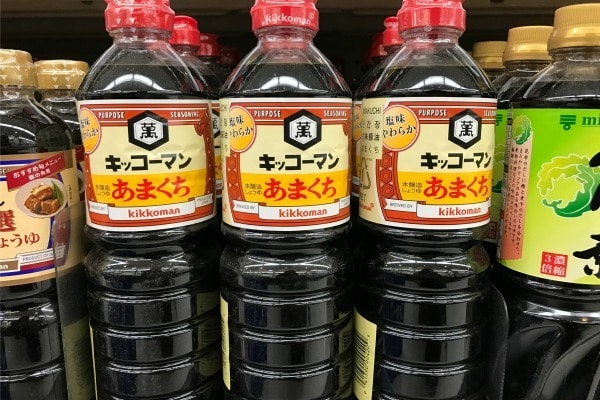
Amakuchi sweet soy sauce is the mainstream choice in southern Japan, where it’s used like regular soy sauce. If using this in cooking, reduce the amount of sugar.
7. Gluten-Free Soy Sauce
Kikkoman USA, as well as other companies, have gluten-free options.
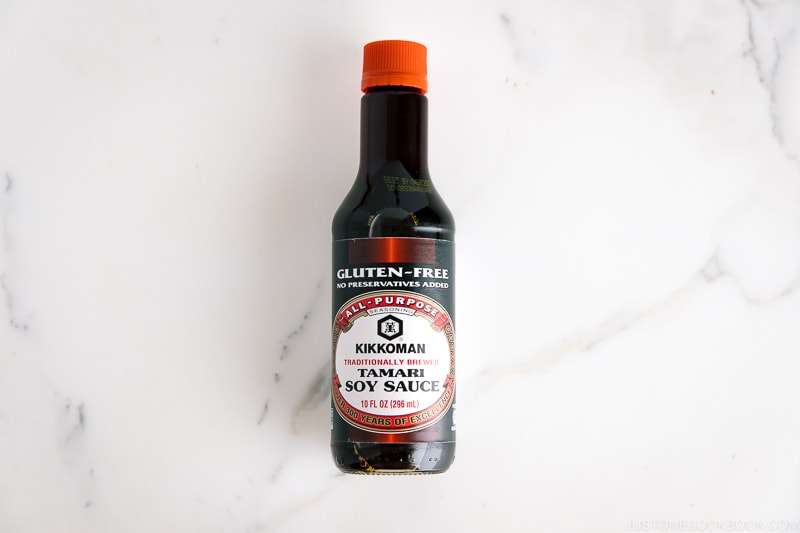
For gluten-free recipes, click here.
How to Choose the Best Soy Sauce
Good quality soy sauce will contain the following: soybeans, wheat or barley, salt, and water. Look for the label with ‘naturally brewed.‘ Avoid those containing preservatives, corn syrup, and additives.
I use Kikkoman for cooking. It is a popular and well-established brand in Japan, affordable, and widely accessible everywhere. Other premium soy sauce brands, such as Yamasa, Kamebishi, and Kishibori are slightly more expensive. Pricer brands are due to small-batch production using a longer fermentation process.
We tried the American-made Bluegrass Soy Sauce. It’s fermented in bourbon barrels, imparting a complex flavor and aroma. It’s excellent for dipping sauces or salad dressings, so I recommend using it as a finishing sauce than for cooking.
Substitutions
Soy sauce is a unique fermented product that defines Japanese cuisine. However, for those allergic to soy, you can use the same amount of coconut aminos or Bragg’s liquid aminos as a substitute for soy sauce.
Coconut aminos is a dark liquid condiment made from the fermented sap of a coconut palm tree and sea salt. While it doesn’t replicate the exact flavor, it provides a slightly salty-savory taste.
Health Benefits
Since it’s a fermented product, soy sauce is a good source of antioxidants, protein, and vitamin K. Being a soy product, it also contains isoflavones, a compound said to reduce menopausal effects and improve cholesterol levels. Some studies even suggest that soy sauce contains more phytonutrient antioxidants than red wine!
There’s no question that soy sauce is salty, but it actually contains less sodium than table salt. A little goes a long way, so use it sparingly.
How to Store Soy Sauce
Before Opening
Store unopened bottles at room temperature in a pantry or dark place, avoiding direct sunlight, heat, and humidity.
After Opening
When soy sauce comes in contact with air, it oxidizes and darkens in color and gradually loses its aroma. To prevent this, make sure to close opened bottles properly.
There is ongoing debate regarding whether opened bottles should be refrigerated or stored at room temperature. Given its high sodium content, soy sauce is considered shelf-stable and unlikely to spoil. While some experts recommend refrigerating premium bottles, the choice ultimately depends on personal preference.
Delicious Recipes Using Soy Sauce

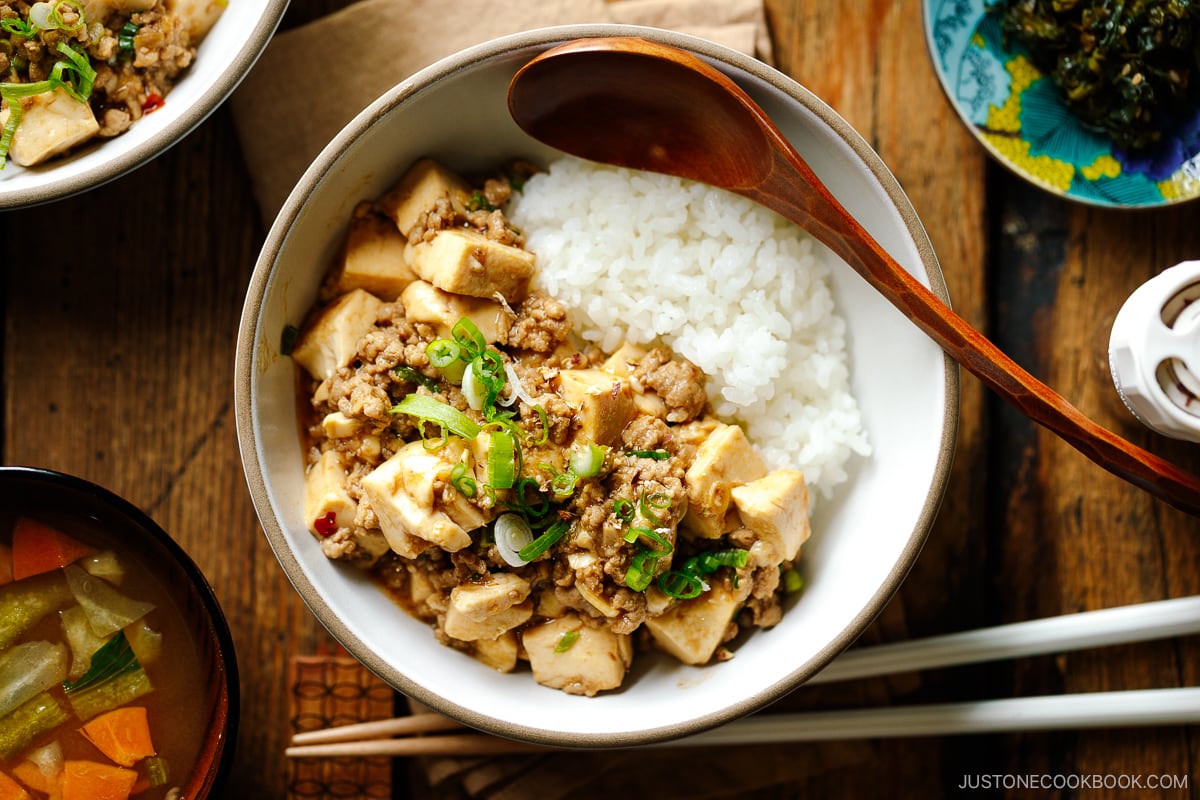
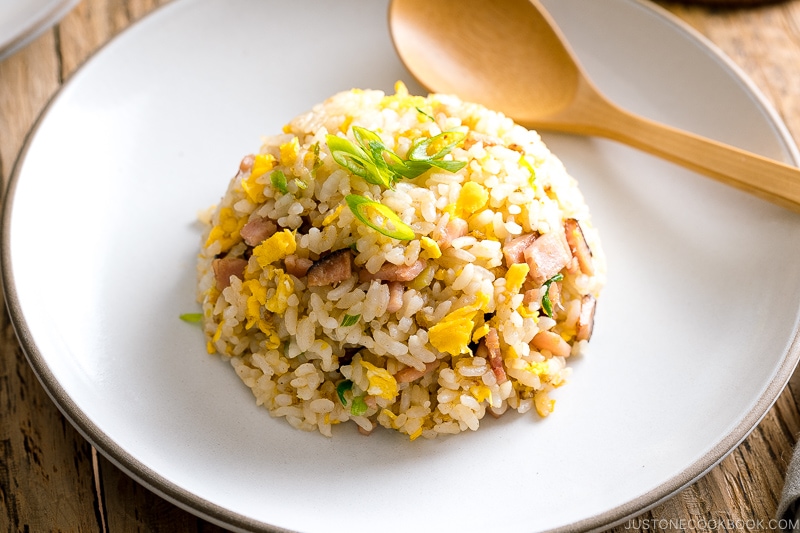
Easy Japanese Fried Rice (Yakimeshi)
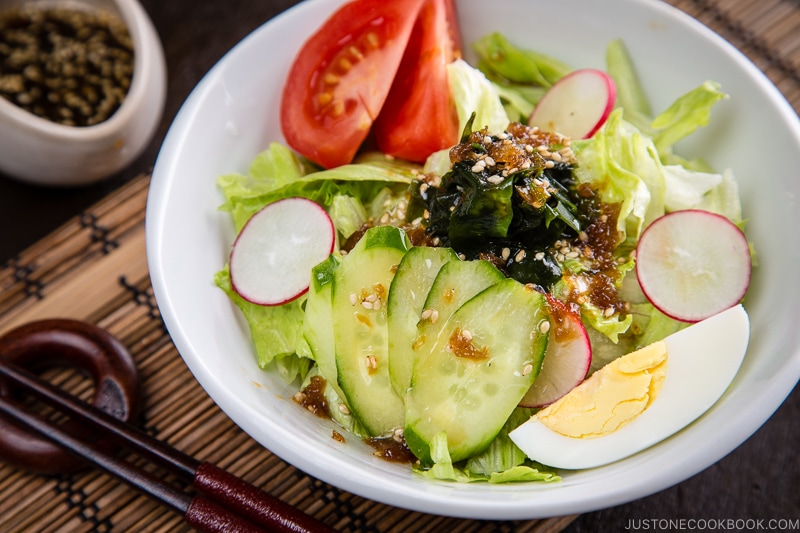
Wafu Dressing (Japanese Salad Dressing)
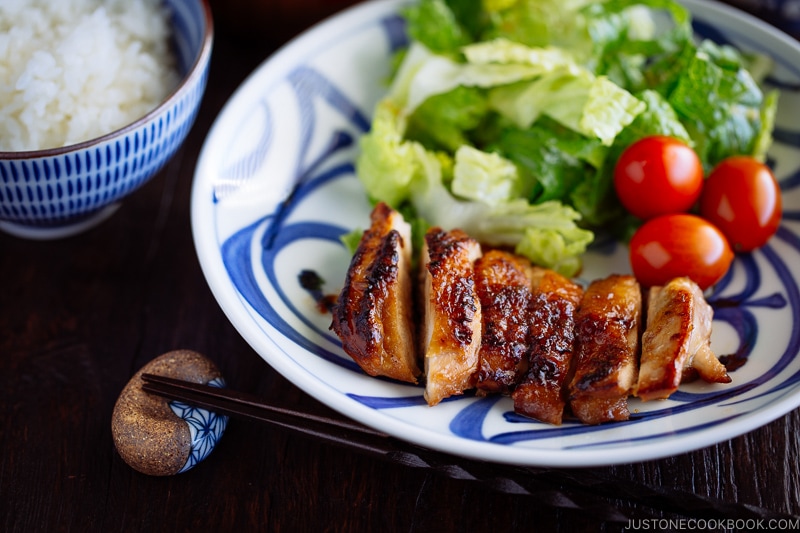

FAQs
Q: Is soy sauce high in sodium?
Soy sauce does contain high salt levels, but it ultimately depends on how much you add to the dish. While you may not immediately notice the difference in saltiness, you will certainly notice its savory fragrance and flavor.
Keep in mind that soy sauce is not a direct replacement for salt, so depending on the recipe, you may still need to add salt, especially when cooking with meat and vegetables. Start with a smaller amount, and adjust to taste as needed.
Q: Can I use normal soy sauce if I’m on a low-sodium diet?
You could opt for a low-sodium soy sauce. You could also decrease the amount of regular soy sauce and increase aromatics such as ginger, garlic, scallions, or spices to enhance the flavor. Most low-sodium brands are made through chemical production, which doesn’t utilize fungal cultures.
Wish to learn more about Japanese cooking? Sign up for our free newsletter to receive cooking tips & recipe updates! And stay in touch with me on Facebook, Pinterest, YouTube, and Instagram.
